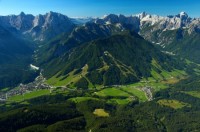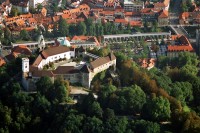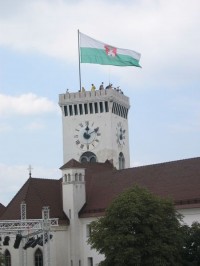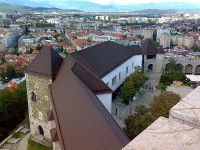Imagine a perfect little pocket sized nation, green as the greenest hills you have ever seen and ruled benevolently from a castle perched on a hill. If you happen to stumble and trip into Slovenia on your way from Austria to Italy or down to Croatia, you will indeed have found it. Slovenia is the oasis in the middle of  Europe that remained filled with beautiful old towns, flowing rivers clean enough to swim in and so many beautiful women its dangerous to walk the streets at night.
Europe that remained filled with beautiful old towns, flowing rivers clean enough to swim in and so many beautiful women its dangerous to walk the streets at night.
Ljubljana, the capital of Slovenia, is a city whose name has two legends swirling around it. One describes Jason and the Argonauts arriving here after snatching away the Golden Fleece and slaying a monster named Ljubljana. The other is about a green eyed princess of ancient times who gave her name to the city, her name was Ljubljena which happens to mean beloved in Slovenian. Could these two myths have something in common?
 Ljubljana is a breezy one hour drive from Italy and four hours from Vienna. A laughing jaunt down the coast gets you to Croatia. The city is very laid back and has all of the old world charm of the great cities of Europe, but is easily accessed by bike. Slovenians throughout history escaped much of the wars that raged between the Hapsburg Kings, Italian Lords and Turkish Sultans. The most traumatic event was a massive earthquake in 1895 that quickly changed the city from a quaint, hidden capital of roughly 10,000 people to a bustling rail-connected city of .. oh .. 15,000. The population stands at 275,000 today.
Ljubljana is a breezy one hour drive from Italy and four hours from Vienna. A laughing jaunt down the coast gets you to Croatia. The city is very laid back and has all of the old world charm of the great cities of Europe, but is easily accessed by bike. Slovenians throughout history escaped much of the wars that raged between the Hapsburg Kings, Italian Lords and Turkish Sultans. The most traumatic event was a massive earthquake in 1895 that quickly changed the city from a quaint, hidden capital of roughly 10,000 people to a bustling rail-connected city of .. oh .. 15,000. The population stands at 275,000 today.
 The main attraction for everyone has to be Ljubljana castle, which gazes down from a rocky promontory onto the classic architecture of Europe at its regal height. The castle hosts a medieval festival every summer and the parade is something to see, with hundreds of actors sinking deep into their roles as pages, knights and buxom beer maids for the entire day.
The main attraction for everyone has to be Ljubljana castle, which gazes down from a rocky promontory onto the classic architecture of Europe at its regal height. The castle hosts a medieval festival every summer and the parade is something to see, with hundreds of actors sinking deep into their roles as pages, knights and buxom beer maids for the entire day.
Having escaped war, Slovenia turned to the arts and Ljubljana is the center of all things artistic in the area. There are several music, arts and design festivals throughout the year, including one of the world’s premier graphic arts fairs — held since 1955. The city has a modern feel amidst the Italian Baroque and the people express it in their dress and style as well as their relaxed way. Slovenians are deeply in love with their city and it shows. The Ljublijanica River is not for swimming, but you can take a boat around the little old town area and it seems that people never work. They just seem to flock the bridges and walkways of the town while holding ice cream, coffee or delicious Slovenian cevapcici (grilled minced meat) with flat bread. Ah, yes…. the food. Slovenians have their own Slavic fare which is delicious and influenced by Greek and Turkish cuisine. But there is also a splash of local pasta, excellent Italian places, as well as old style German and Austrian spots that have been there since the 13th or 14th century.
I f the cities of Europe have bedazzled you to the point of abstraction, then turn north to the Alps. Just a couple of hours away, you can spend a weekend in a lodge, visit mountain towns and ski, or just pass through wildflower-blanketed valleys on a lazy summers day. And Slovenians love to head south to the Adriatic Sea where they share the beautiful coast with Croatians and vacationing Europeans. These inviting, seaside towns were havens for lovers of life before WWI, but then fell into “obscurity” while the hot and cold wars of the 20th century took every one’s mind off of living. Times are changing and the coastal towns are filling up with people of other than Slavic descent. But, the slow easy life persists and this stunning sea shore offers a nice alternative to the Cote d’azure or the Greek islands.
f the cities of Europe have bedazzled you to the point of abstraction, then turn north to the Alps. Just a couple of hours away, you can spend a weekend in a lodge, visit mountain towns and ski, or just pass through wildflower-blanketed valleys on a lazy summers day. And Slovenians love to head south to the Adriatic Sea where they share the beautiful coast with Croatians and vacationing Europeans. These inviting, seaside towns were havens for lovers of life before WWI, but then fell into “obscurity” while the hot and cold wars of the 20th century took every one’s mind off of living. Times are changing and the coastal towns are filling up with people of other than Slavic descent. But, the slow easy life persists and this stunning sea shore offers a nice alternative to the Cote d’azure or the Greek islands.


Comments